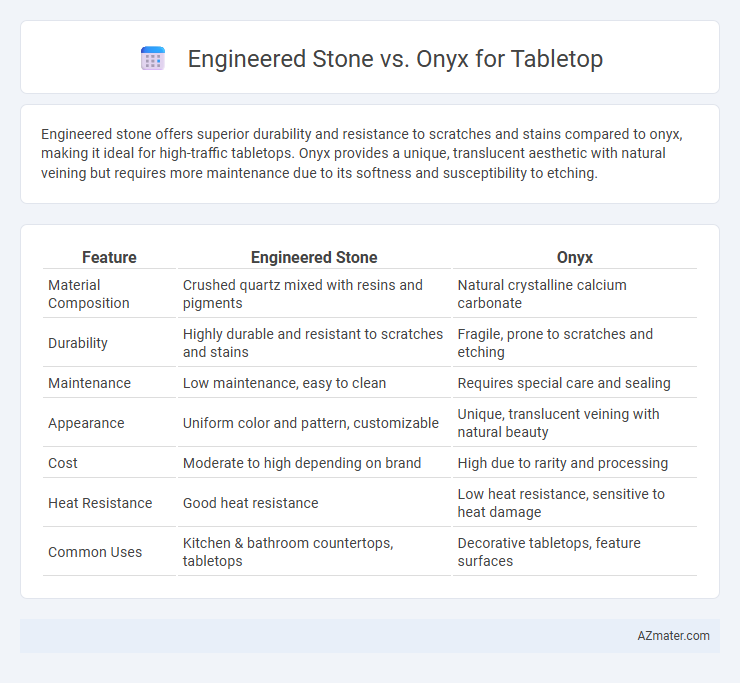Engineered stone offers superior durability and resistance to scratches and stains compared to onyx, making it ideal for high-traffic tabletops. Onyx provides a unique, translucent aesthetic with natural veining but requires more maintenance due to its softness and susceptibility to etching.
Table of Comparison
| Feature | Engineered Stone | Onyx |
|---|---|---|
| Material Composition | Crushed quartz mixed with resins and pigments | Natural crystalline calcium carbonate |
| Durability | Highly durable and resistant to scratches and stains | Fragile, prone to scratches and etching |
| Maintenance | Low maintenance, easy to clean | Requires special care and sealing |
| Appearance | Uniform color and pattern, customizable | Unique, translucent veining with natural beauty |
| Cost | Moderate to high depending on brand | High due to rarity and processing |
| Heat Resistance | Good heat resistance | Low heat resistance, sensitive to heat damage |
| Common Uses | Kitchen & bathroom countertops, tabletops | Decorative tabletops, feature surfaces |
Introduction: Comparing Engineered Stone and Onyx Tabletop Options
Engineered stone offers exceptional durability, resistance to stains, and ease of maintenance, making it a practical choice for tabletops in high-traffic areas. Onyx provides a unique, translucent aesthetic with natural veining that enhances luxury and elegance but requires careful upkeep due to its softness and susceptibility to scratching. Both materials balance functional performance and visual appeal, with engineered stone excelling in robustness and onyx standing out for distinctive, premium design.
Appearance and Aesthetic Differences
Engineered stone offers a consistent, uniform appearance with a wide range of colors and patterns that mimic natural stone, making it ideal for modern, sleek tabletops. Onyx features translucent qualities with striking, unique veining and color variations, providing a luxurious and dramatic aesthetic often enhanced by backlighting. The choice between engineered stone and onyx ultimately depends on whether a durable, versatile surface or an exclusive, artistic statement piece is desired for the tabletop.
Durability and Longevity Compared
Engineered stone offers superior durability and longevity for tabletops due to its high resistance to scratches, stains, and impact, making it ideal for daily use. Onyx, while visually striking with its translucent properties, is softer and more prone to etching and chipping, resulting in reduced lifespan under heavy wear. Choosing engineered stone ensures longer-lasting performance with minimal maintenance in high-traffic tabletop applications.
Maintenance Requirements: Which Is Easier to Care For?
Engineered stone offers superior durability and resistance to stains, making it easier to maintain for tabletops compared to onyx. Onyx requires regular sealing and gentle cleaning to prevent etching and damage from acidic substances. Engineered stone's low porosity and scratch resistance significantly reduce the frequency of upkeep and enhance long-term care convenience.
Resistance to Stains, Scratches, and Heat
Engineered stone offers superior resistance to stains, scratches, and heat due to its dense composition of crushed quartz and resin, making it ideal for high-traffic tabletops. Onyx, while visually striking with its translucent beauty, is more prone to scratching and etching from acidic substances, and requires careful sealing to protect against stains and heat damage. When durability and low maintenance are priorities, engineered stone outperforms onyx in preserving the tabletop's appearance and structural integrity.
Cost and Price Considerations
Engineered stone typically offers a more budget-friendly option for tabletops compared to onyx, with prices averaging between $50 to $100 per square foot, whereas onyx can range from $100 to $250 per square foot due to its rarity and unique translucence. Cost factors for engineered stone include durability and low maintenance, contributing to long-term savings, while onyx demands regular sealing and careful handling, increasing maintenance expenses. Choosing between these materials depends on balancing initial investment with upkeep costs and desired aesthetic value.
Installation Process and Customization Flexibility
Engineered stone offers a streamlined installation process with uniform slabs that simplify cutting and fitting, reducing labor time and errors compared to natural onyx. Onyx requires expert handling during installation due to its translucency and fragility, demanding specialized adhesives and reinforcement to prevent cracking. Engineered stone provides greater customization flexibility with consistent color patterns and thickness options, while onyx allows unique, natural veining but limits modification without compromising structural integrity.
Environmental Impact and Sustainability
Engineered stone, composed primarily of crushed quartz and resin, offers a more sustainable option for tabletops due to its durability and reduced need for frequent replacement, minimizing waste over time. Onyx, a natural stone known for its striking translucency, requires intensive quarrying processes that can significantly disrupt ecosystems and result in higher carbon emissions. Choosing engineered stone supports environmental preservation through efficient resource use and lower environmental footprint compared to the extraction and processing demands of onyx.
Popular Uses and Design Applications
Engineered stone is widely favored for tabletops due to its durability, resistance to stains and scratches, and consistent appearance, making it ideal for high-traffic dining and kitchen surfaces. Onyx, prized for its translucent and unique veining, is primarily used in luxury tabletops and decorative accents where aesthetic impact and backlighting effects are desired over heavy use. Designers often select engineered stone for functional applications requiring low maintenance, while onyx is chosen for statement pieces that emphasize visual elegance and artistic appeal.
Pros and Cons: Engineered Stone vs Onyx Tabletop
Engineered stone tabletops offer high durability, resistance to scratches and stains, and a wide variety of consistent patterns, making them ideal for heavy-use areas. Onyx tabletops provide a unique, translucent beauty with natural veining and a luxurious aesthetic but are softer and more prone to scratches, chips, and staining, requiring more careful maintenance. Choosing between engineered stone and onyx depends on balancing durability and low maintenance with the desire for an exclusive, decorative appearance.

Infographic: Engineered stone vs Onyx for Tabletop
 azmater.com
azmater.com